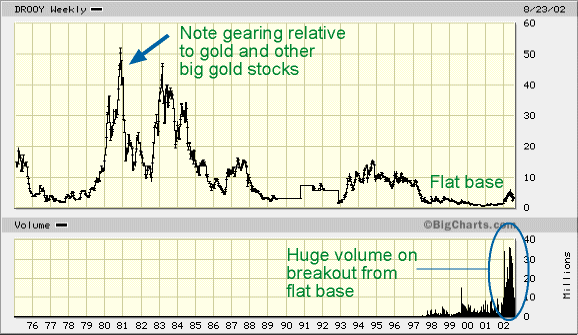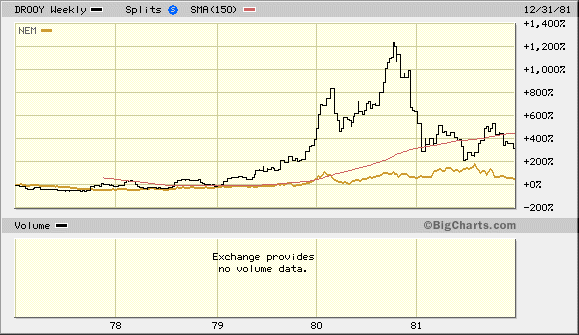Durban Roodepoort Deep
Welcome to the land of opportunity! The long-term chart of Durban Deep is one of the most bullish charts I have seen in my entire life. Readers of other reports by me will know that I have, throughout the late summer period, remained very bullish of gold and gold stocks, despite the ongoing severe correction, which I believe has now run its course. Being aware that the stocks of larger gold companies had become overpriced on an intermediate term basis, I concentrated my work on the stocks of highly leveraged, small exploration companies, which had been somewhat overlooked in the stampede into the larger front line stocks. So imagine my surprise and delight when I looked at the chart of Durban Deep a few days ago, the first time I had looked at this chart for a while, and saw not only the hugely impressive long-term chart but was also very pleased to observe that the intermediate term correction in force since early June has now almost completely run its course and brought the price down to what I regard as an excellent entry point.
Upon viewing the long-term chart of Durban Deep I have been forced to amend my forecast for gold and the gold share market from "very bullish" to "mega bullish". I cannot over-emphasize the importance of what the long-term chart for Durban Deep reveals, not only for the future of the company itself, but also for the entire South African mining industry and more broadly the global gold mining industry at large.

I will now share my observations with readers so that you may, as much as possible, comprehend the reasons for my exceedingly bullish outlook. Look first at the long-term chart (see above) which goes way back to 1975 and therefore includes the climactic years of the last gold boom. The first point to note is the gearing (i.e. leverage) relative to the gold price and to other large producers. During 1979 and 1980, the price rose from about $3 to over $50, an increase of over 1500%! The second important point is the evolution of a low flat base between 1997 and the end of last year. I have seen many such bases in the course of my research. They represent a "sink or swim time" and frequently involve a fundamental restructuring and realignment of a company. Companies that survive such a period normally emerge from it in a lean and highly efficient state, having stripped out all the dead wood and dross and cut discretional costs to a minimum. What is really exciting is when you find a company that has done all that, as the chart suggests that Durban Deep has done, and then at the end of it the company is duly rewarded for its perseverance by finding that the market for its products is rapidly improving, which brings me to my next point, the most important of all.
So now let's put 2 and 2 together. We have here a company that has survived a very lean period, restructured and realigned itself and cut costs to the bone and then, in a relatively short period of time, the market for its product improves substantially. What does it mean? - a whacking great increase on the bottom line - a big increase in profits, that's what it means. Now look again at that long-term chart and observe the colossal volume this year - this is a buying frenzy by buyers who have put 2 and 2 together. "Ah", but I hear thousands of you would be buyers cry, "gold can't go up much, might even go down, because the market is manipulated - "they" won't allow it to go up, because of their huge short positions and will get the central banks to dump palettes of gold bars on the market if it threatens to". Oh, really? I'll tell you what I think of this widely disseminated theory. I think there is fair probability that it is a smokescreen to put ordinary investors off buying gold stocks, indeed to get them to sell, and also to prevent run-of-the-mill market advisors and letter writers from recommending them to their clients. GATA et al may even be "on the payroll" of this plot, if that's what it is - but I emphasize that this is an unsubstantiated suspicion on my part. Meanwhile, smart money has "backed up the truck" and is getting gold stocks on board like there's no tomorrow. When the time is right GATA et al will simply "evaporate" as gold goes steaming up. Even if these stories about huge short positions are true, it is quite within the realms of possibility that wealthy smart money investors are buying heavily while leaving corporate entities, who they possibly work for, to carry the can with the huge short positions. Again, if true, such short positions will eventually lead to a buying panic as those on the wrong side rush to cover or face ruin. If GATA and its associates are indeed correct, and I haven't ruled this out, Bill Murphy and the gang are making so much noise about this now that it can't be that long before the accused, that is to say, Goldman, JP Morgan and the others are dragged before the regulators and the matter is addressed. Either way gold goes up, either way, we as gold investors, win. The losers will be the mugs who have allowed this "red herring" story to deflect them from the opportunity of a lifetime. My bottom line in all this is that the charts say that gold shares are being heavily accumulated, and are going up and going up enormously.

Once the price of Durban Deep stock establishes itself above $5.00, it will become a marginable stock in the eyes of many of the largest US brokerage houses, that is it will be eligible to be purchased on margin, substantially increasing demand for the stock.
At present Durban Deep is not held by many Institutional investors such as Mutual Funds and Pension /Retirement programs, again because the price is below $5 and at current levels the stock is considered to be too volatile. This too will change as the price establishes itself above $5.
The company's gold properties enjoy probably the highest leverage to the price of gold of any large producer in the world. This is dramatically illustrated in the chart below, which shows the performance of Durban Deeprelative to Newmont Mining during the 1977 - 1982 period. The black line is the price of Durban Deep stock, the brown line is the price of Newmont stock (both unscaled) and the smooth red line shows how Durban Deep outperformed Newmont during this period with the degree of out-performance being quantified on the scale at the right side of the chart.

Most of its marginal gold deposits will come into production, once the price of gold hits $350/oz. This will catapult earnings. The chart below illustrates the huge stock price appreciation that occurred on a rising gold price between 1977 and 1980.

Over the next several years I am looking for Durban Deep stock to return to the $40 - $50 area, at least.
In the intermediate-term the stock is expected to complete the basing process within the next few weeks, and then enter into a renewed intermediate uptrend, which should take the price to at least $10.The new uptrend will be signalled by a break of the red downtrend line shown on the short-term chart.
Short-term the price is expected to fluctuate in a fairly narrow range between approximately $2.50 and $3.70 over the next week or two, bringing to an end the intermediate downtrend in force since June, and setting the stage for the new uptrend.
Durban Roodepoort Deep Ltd, symbol DROOY
closing price: $3.41 approx. on 26 August 2002



















